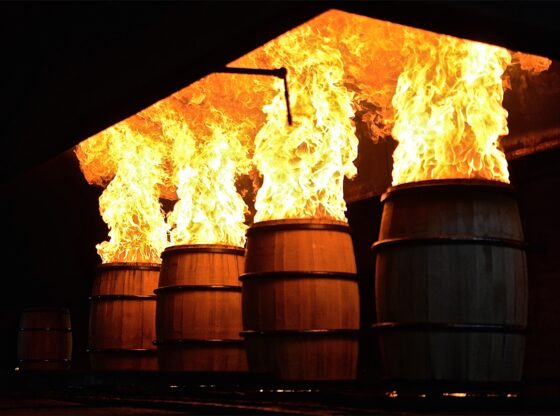
By Hendre’ Barnard, Training and Marketing Manager
Distillique Beverage (Pty) Ltd.
https://distillique.co.za
Charring Levels in Barrels
To decide the charring levels in a barrels, a cooper has to select their oak type, barrel size and seasoning qualities, then they can then select which level of thermal degrading to apply to the inside of the cask relative to the liquid it will have in it and the desired character of that liquid.
What is the difference between Toasting and Charring?
The two most common types of thermal degrading are toasting and charring.
While toasting is a generally common practice for all barrels used in Wine, Fortified Wine and Cognac; charring is a direct result of the American whiskey process. ‘Straight Bourbon’, ‘Tennessee’ and ‘Straight Rye’ whiskeys are restricted by law to only using new charred barrels. And with over 700 registered whiskey distilleries across the United States, it should come as no surprise that the majority of the worlds matured spirits are done so in ex American charred barrels.
Can I reuse a Barrel?
While Scotch cooperage’s also actively engage in charring, it’s predominantly for the use of reinvigorating ex American whiskey barrels.
Traditionally, a barrel filled 4 times represented the end of a barrels life, but with such high demand and low supply of barrels these days, most cooperage’s engage what is known as ‘dechar / rechar’ to further extend the life of a barrel.
Dechar simply scrapes off the old alligator charring on the wood, taking the oak back down to a near fresh grain before the barrels are then recharred at up to 1400° Celsius ready for a fresh fill.
Generally speaking, the only time a whisky might meet a non-charred Barrel is when they are adding a unique ‘finish’ to their spirit. Sherry, Port and Madeira Barrels used for maturing are the best examples as they are almost always toasted. Deep charring tends to overwhelm the delicacies of most fortified wines.
Even when these same barrels are purchased by Scotch producers for use as a finish to their whisky, they don’t need to be reinvigorated like ex bourbon barrels, as doing so would remove most of the wine flavours already absorbed into the oak. And with the average sherry butt selling for almost 14 times the price of an ex American whiskey barrel, you’ll want to get your moneys’ worth.
Why do we char barrels?
There are three reasons why barrels are charred.
- To generate a layer of active carbon which removes undesirable flavour substances
- To affect the release and dissolution of flavour compounds such as vanillin during maturation
- To yield colour and phenolic substances which result in new flavour compounds by oxidative interactive reactions
In basic terms, charring helps to open up micro channels allowing the spirit to absorb deep into the oak, further extracting aromatic aldehyde’s, increasing the release of vanillins and further absorbing undesirable flavour congeners in the process. By converting the top layer of oak into carbon charcoal, some of the wood sugars (hemicellulose) are converted into caramel notes while also acting like an activated carbon filter in a water bottle and filtering out unpleasant sulphur flavour compounds.
What are the different Levels of Char?
While charring is an exciting process to witness in any cooperage, as always, there is further devil in the detail.
For a traditional whisky distiller, there are four core char levels simply graded from numbers 1-4 with the lower number representing a shorter exposure to heat and softer char level.
- No.1 Char: 15 seconds
- No.2 Char: 30 seconds
- No.3 Char: 45 seconds
- No.4 Char: 55 seconds (a.k.a. ‘alligator char’ due to its textured skin)
While the vast majority of American Whiskey distillers prefer either a No.3 or No.4 char on their barrels, a number of distilleries have experimented with even heavier levels. Buffalo Trace Distillery, as an example, released a No.7 Heavy Char Barrel Bourbon.
The overall difference between a No.3 and No.4 char on a Whisky as explained by Brad Boswell, the President and fourth-generation cooper of the Independent Stave Company:
“The lighter char preserves more of the natural oak aroma and flavour (think a little spicy, a little earthy, with a touch of cedar). The heavier char provides more colour and caramelization. Tannins will vary between these two types of barrels. The heavier char can also provide for more of a sweet smoke note that is often desired.”
In addition to the selected char level, the alcoholic strength of the spirit within also influences the rate and reaction of the char. The strength of an alcohol varies the release of flavour compounds in toasted or charred oak as it would if you were macerating your own aromatic bitters. A higher proof spirit tends to release richer levels of vanillins from char while lower strength sees less vanilla release but more sweetness from natural sugars.
Barrel sizes, conditioning, charring and chemistry all play essential roles in defining the final character of a mature spirit.
How Barrel Storage Affects Barrel ABV
Water molecules are small, Alcohol molecules are much larger.
Since a water molecule is very small, it is easier for it to escape through the barrel than the much larger alcohol molecule. The atmosphere at the top of a barrel storage area is very hot and dry, allowing the water molecules to escape much faster than the alcohol molecules, thus driving the ABV up in those barrels and concentrating the flavours inside the barrel.
Barrels at the top of a Barrel Storage Area therefore ages at an accelerated pace due to Water Molecules in those barrels escaping easier – the ABV Raises to around 70 to 75%
The atmosphere at the bottom of the Barrel Storage area is moist and cool. Since a water molecule is very small, water can penetrate the barrel from the surrounding moisture and that drives the ABV down in those barrels.
Barrels at the bottom of a Barrel Storage Area therefore ages at a slower pace due to Water Molecules absorption – the ABV drops to around 55%
Barrels at the middle of the Barrel Storage Area, what the late Booker Noe of Jim Beam called the “Centre Cut”, stay more constant, varying just a little, as you will not experience extreme fluctuations.
1 High, 2 High, 3 High
In a typical American Barrel Storage Area (called a Rackhouse) there are 9 floors, with three barrels on each floor – we call those the one high, two high, and three high.
Between the 9 floors in the Rackhouse, that makes it 27 barrels tall in total. ABV Percentages vary from floor to floor due to temperature and humidity.
Barrels on the inside of the Rackhouse also ages differently than those on the outside as well, since the barrels on the outside get more heat closer to the walls.
Where you put the barrels therefore affects those barrels in different ways.
Single Barrel vs. Small Batch
Some distilleries use the location of the bourbon in the rackhouse as their small batch. Many barrels are mingled together for a small batch so that those have a consistent taste from bottle to bottle and batch to batch over the years.
A single barrel is (supposed to be) bottled from only one barrel at a time. So, if we bottle whisky from a barrel two high on the 3rd floor – and then bottle from a barrel one high on the 6th floor – the two sets will taste very differently.
At Buffalo Trace Distillery, they have wood and tin, brick, and concrete block Rackhouses (3 different types).
Whisky ages differently in each type of house, so they put certain bourbons in certain types of houses, and that’s what creates the differences in their small batch and single barrels.
A Practical Example
Let us say you receive three barrels of Whisky, filled with distillate from the same batch.
You decide to store one barrel in your basement, the second on your main floor, and the third one in your attic.
Assuming you have no central heating, air conditioning or insulation, it is expected that you will experience a temperature variance between the 3 levels.
You leave the 3 barrels in their unique locations for 12 years, tasting them at different intervals.
- Single Barrel
Do you think that over those 12 years, when you tasted Whisky from those barrels and compared them, that they might taste a little different from each other?
Of course, they would – and that’s what Single Barrel is.
- Small Batch
If we mingled a little bit of those same thee barrels together each time we tasted, we would get a similar taste to each other from bottle to bottle – and that’s Small Batch.
That’s the difference between Single Barrel and Small Batch distinctions.

